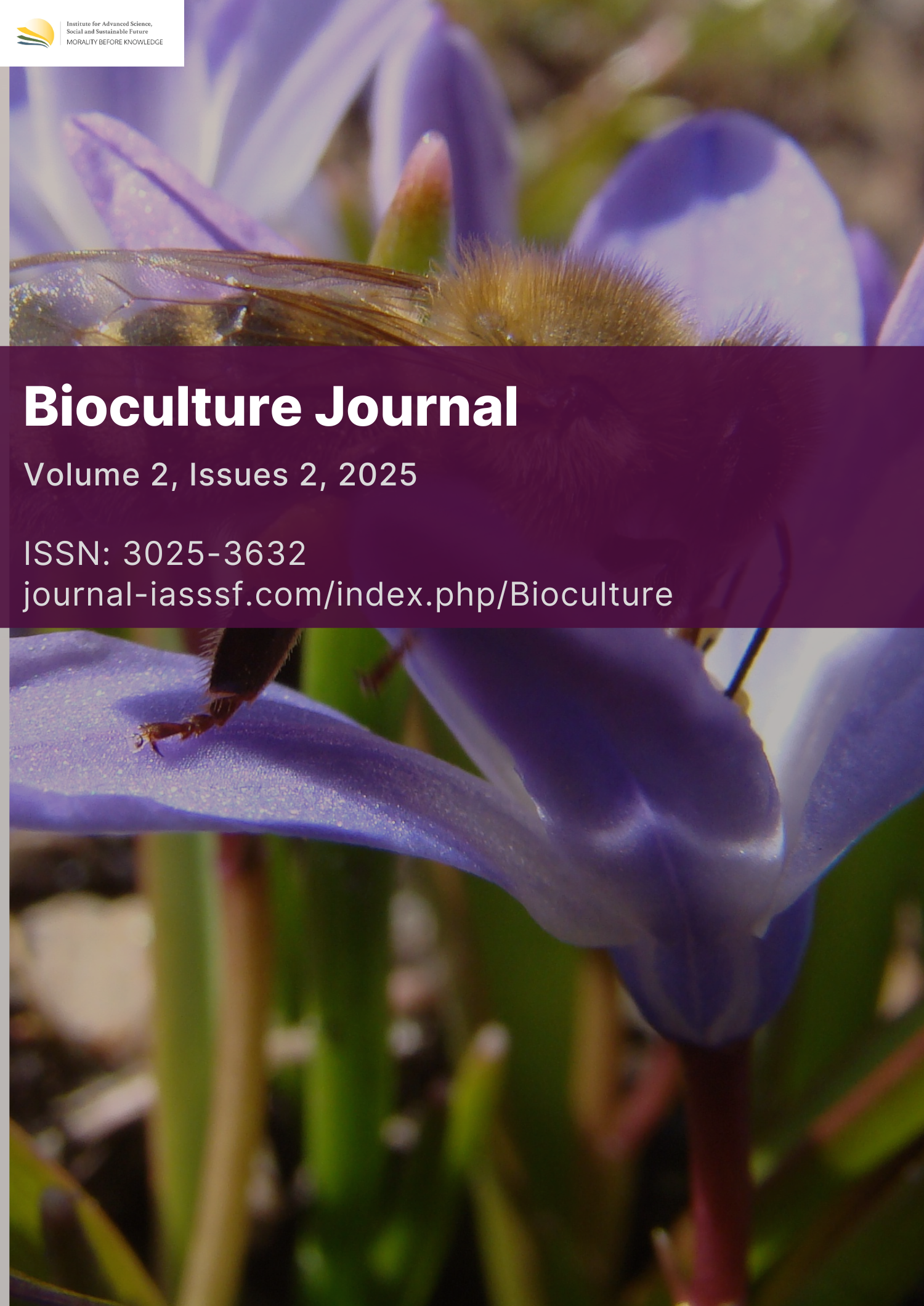Study on the decline of wildlife population in nature due to illegal breeding and hunting: Implications for biodiversity conservation
DOI:
https://doi.org/10.61511/bioculture.v2i2.2025.1494Keywords:
law enforcement, illegal trade, wildlifeAbstract
Background: Poaching of wildlife, including protected species, is on the rise, partly due to increased demand in the world market. Therefore, this journal aims to examine the problems faced by Indonesia in dealing with wildlife trade crimes that still occur frequently, as well as the implementation of Law Number 5 of 1990 related to law enforcement for wildlife protection in Indonesia. Methods: The research method used is qualitative, by collecting data from books, articles, news, and journals. The analysis involved theories, concepts, legal principles, and regulations in the Act, as well as related case studies in Indonesia. Findings: The results show that although Indonesia has Law No. 5 of 1990, it is still lacking in effectiveness in reducing poaching and trade of wild and protected animals. Law enforcement officials and related agencies face various problems in the implementation of law enforcement. Community involvement in the endangered species trade is a key driver of the illegal keeping trend in Indonesia. Conclusion: The rate of prosecutions and convictions of illegal keepers remains low, creating inequalities in sentencing and giving the impression that the risks of this illegality are relatively low compared to the financial gains possible. Novelty/Originality of this article: This article highlights that collaboration between the government, communities and non-governmental organizations can provide additional support in conservation efforts and handling illegal cases.
References
Adams, J. (2018). Understanding the Illegal Wildlife Trade: A Criminological Analysis. Palgrave Macmillan.
BirdLife International. (2021). Illegal Bird Trade in Indonesia. https://datazone.birdlife.org/sowb/casestudy/developing-a-market-based-solution-to-the-bird-trade-in-indonesia.
BirdLife International. (2022). Leucopsar rothschildi. https://datazone.birdlife.org/species/factsheet/22710912.
BirdLife International. (2022). Nisaetus bartelsi. https://datazone.birdlife.org/species/factsheet/22696165.
BirdLife International. (2022). Paradisaeidae. https://datazone.birdlife.org/species/search.
BPS. (2023). Statistik Ekonomi Lingkungan Hidup Indonesia 2023. Badan Pusat Statistik.
Cleary, D. F. R., & DeVantier, L. (2011). Indonesia: Threats to the country's biodiversity. Encyclopedia of Environmental Health, 187-197. https://doi.org/10.1016/B978-0-444-52272-6.00504-3
Conservation International (CI). (2021). Wildlife Trade in Indonesia: A Survey Analysis. Conservation International.
Convention on International Trade in Endangered Species of Wild Fauna and Flora. (2022). Enforcement Matters: A Compilation of Decisions of the Conference of the Parties Related to Enforcement. https://cites.org/eng/disc/text.php.
Convention on International Trade in Endangered Species of Wild Fauna and Flora. (2022). CITES Appendices. https://cites.org/sites/default/files/eng/app/2022/E-Appendices-2022-06-22.pdf.
Creswell, J. W. (2017). Research design: Qualitative, quantitative, and mixed methods approaches. Sage publications.
Dasgupta, P. (2021). The Economics of Biodiversity: The Dasgupta Review. HM Treasury.
Dinerstein, E., Vynne, C., Sala, E., Joshi, A. R., Fernando, S., Lovejoy, T. E., Mayorga, J., Olson, D., Asner, G. P., Baillie, J. E. M., Burgess, N. D., Burnkart, K., Noss, R. F., Zhang, Y. P., Baccini, A., Birch, T., Hahn, N., Joppa, L. N., & Wikramanayake, E. (2020). A Global Deal for Nature: Guiding Principles, Milestones, and Targets. Science Advances, 5(4). https://doi.org/10.1126/sciadv.aaw2869
DWNP (2020). Javan Rhino Population and Habitat Viability Assessment. Directorate General of Natural Resources and Ecosystem Conservation, Ministry of Environment and Forestry. https://ksdae.menlhk.go.id/artikel/12204/Memahami-Kondisi-Badak-Jawa-Terkini.html
Environmental Investigation Agency (EIA). (2021). Caging the Tiger: Seizures of Tigers and Other Asian Big Cats. https://eia-international.org/wp-content/uploads/Off-the-Hook-2021-SPREADS.pdf.
FLI. (2023). Evaluasi Penanganan Kasus Pemeliharaan Satwa Dilindungi Ilegal. Forest Legality Initiative.
Forensic Working Group. (2014). Wildlife Crime: A Guide to the Use of Forensic and Specialist Techniques in the Investigation of Wildlife Crime. Crown.
Forest Watch Indonesia. (2022). Potret Lemahnya Penegakan Hukum Pelestarian Satwa Langka di Indonesia. Bogor: Forest Watch Indonesia.
Harfoot, M., Glaser, S. A. M., Tittensor, D. P., Britten, G. L., McLardy, C., Malsch, K., & Burgess, N. D. (2018). Unveiling the patterns and trends in 40 years of global trade in CITES-listed wildlife. Biological Conservation, 223, 47-57. https://doi.org/10.1016/j.biocon.2018.04.017
Hughes, A., Auliya, M., Altherr, S., Scheffers, B., Janssen, J., Nijman, V., Shepherd, C. R., D'Cruze, N., Sy, E., & Edwards, D. P. (2023). Determining the sustainability of legal wildlife trade. Journal of Environmental Management, 341, 117987. https://doi.org/10.1016/j.jenvman.2023.117987
Indonesia Wildlife Trade Monitoring Network. (2022). Kajian Tingkat Keadilan Hukum terhadap Pelaku Perdagangan Satwa Dilindungi. Indonesia Wildlife Trade Monitoring Network.
International Rhino Foundation (IRF). (2021). Javan Rhino. https://rhinos.org/about-rhinos/rhino-species/javan-rhino/
IUCN. (2020). IUCN Status Report on Javan Rhino 2020. IUCN.
Jepson, P. & Ladle, R.J. (2015). Indonesia's endemic birds in crisis. Oryx.
Jones, P. J. S., et al. (2019). Wildlife Trade and Global Disease Emergence. Emerging Infectious Diseases, 25(1), 63–73. https://doi.org/10.3201/eid1107.050194
KLHK. (2022). Survei Persepsi Masyarakat tentang Perdagangan Satwa Langka. Kementerian Lingkungan Hidup dan Kehutanan.
Lambert, V. A., & Lambert, C. E. (2012). Qualitative descriptive research: An acceptable design. Pacific Rim International Journal of Nursing Research, 16(4), 255-256. https://he02.tci-thaijo.org/index.php/PRIJNR/article/view/5805
LAPAN. (2021). Laporan Konflik Orangutan-Manusia di Kalimantan Tengah. LAPAN.
Mahkamah Agung. (2022). Laporan Tahunan Mahkamah Agung 2022. Mahkamah Agung Republik Indonesia.
Meijaard, E., Sherman, J., Ancrenaz, M., Wich, S. A., Santika, T., & Voigt, M. (2018). Orangutan Populations Are Certainly Not Increasing in the Wild. Current Biology, 28(21), 1241-1242 https://doi.org/10.1016/j.cub.2018.09.052
Ministry of Environment and Forestry. (2019). National Tiger Recovery Plan. Ministry of Environment and Forestry.
National Geographic Society. (2019). Wildlife Crime Tech Challenge: Understanding Law Enforcement Responses to Wildlife Crime. National Geographic Society.
Nijman, V. (2020). Orangutan Trade and the Role of Zoos. Global Ecology and Conservation.
Pereira, H. M., & Linkie, M. (2015). Biodiversity risks from fossil fuel extraction. Science, 349(6248), 734-735. https://doi.org/10.1126/science.1237261
Puspitasari, P., Herdiansyah, H., & Asteria, D. (2021). Protecting biodiversity: The importance of understanding the role of government and society in human-urban wildlife interaction in Indonesia. IOP Conference Series: Earth and Environmental Science, 819(1), 012046. https://doi.org/10.1088/1755-1315/819/1/012046
Ripple, W.J. et al. (2016). Saving the World's Terrestrial Megafauna. Biological Conservation.
Riyadi, A., Sunardi, & Setiono, J. (2023). Legal Protection of Biological Resources and Its Ecosystems in Indonesia. International Journal of Law and Politics Studies, 5(1), 77-85. https://doi.org/10.32996/ijlps.2023.5.1.10
Samal, R., & Dash, M. (2023). Ecotourism, biodiversity conservation and livelihoods: Understanding the convergence and divergence. International Journal of Geoheritage and Parks, 11(1), 1-20. https://doi.org/10.1016/j.ijgeop.2022.11.001
Setiawan, A., et al. (2018). Climate change's impact on the breeding grounds of Javan Hawk-eagle. Biological Conservation.
Sunarto, Kelly, M. J., Parakkasi, K., Klenzendorf, S., Septayuda, E., Kurniawan, H. (2018). Tigers Need Cover: Multi-scale Occupancy Study of the Big Cat in Sumatran Forest and Plantation Landscapes. PLoS ONE. https://doi.org/10.1371/journal.pone.0030859
TRAFFIC Southeast Asia. (2023). Mitigasi Politik Uang dalam Peradilan Kasus Perdagangan Satwa Dilindungi. TRAFFIC Southeast Asia.
Traffic. (2021). Combating Illegal Wildlife Trade. https://www.traffic.org/.
Wich, S. A., et al. (2016). Recent Declines in Sumatran Orangutan (Pongo abelii) Populations. Biological Conservation.
Wich, S.A., Singleton, I., Nowak, M. G., Atmoko, S. S. U., Nisam, G., Arif, S. M., Putra, R. H., Ardi, R., Fredriksson, G., Usher, G., Gaveau, D. L. A., Kühl, H. J. (2016). Land-cover changes predict steep declines for the Sumatran orangutan. Science Advances, 2(3). https://doi.org/10.1126/sciadv.1500789
Wildlife Conservation Society (WCS). (2020). Our Work. https://www.wcs.org/our-work?gad_source=1&gclid=CjwKCAiAhJWsBhAaEiwAmrNyq4UZHoNkEaz7zamYpz-UsSkedwNPMKorgAhtr6OrvwAkPGJDGNlxchoC7YUQAvD_BwE.
World Wildlife Fund (WWF) Indonesia. (2021). Sumatran Tiger Conservation Strategy 2021-2030. https://www.wwf.id/id/learn/forest-wildlife/sumatran-tiger.
WWF Indonesia. (2018). Tiger Protection Unit: Penjaga Harimau Sumatera. WWF-Indonesia. https://wwf.id/id/blog/tim-monitoring-harimau-melacak-datuk-belang-agar-tetap-lestari
WWF. (2022). Sumatran Tiger. https://www.wwf.id/id/learn/forest-wildlife/sumatran-tiger.
Downloads
Published
How to Cite
Issue
Section
Citation Check
License
Copyright (c) 2025 Muhammad Rianzar, Hanif Kusuma

This work is licensed under a Creative Commons Attribution 4.0 International License.

















